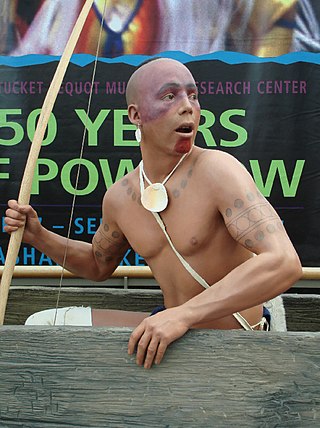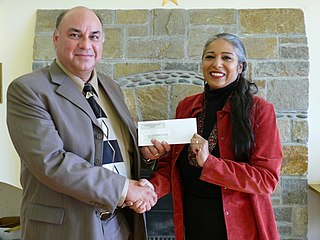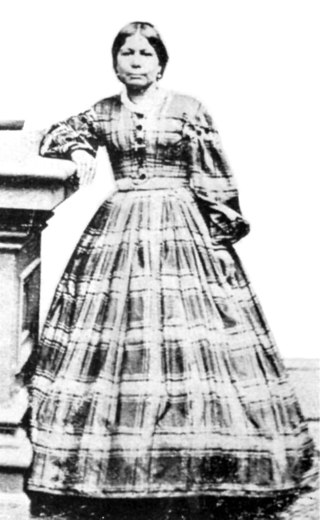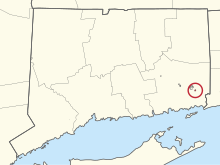
Native American gaming comprises casinos, bingo halls, slots halls and other gambling operations on Indian reservations or other tribal lands in the United States. Because these areas have tribal sovereignty, states have limited ability to forbid gambling there, as codified by the Indian Gaming Regulatory Act of 1988. As of 2011, there were 460 gambling operations run by 240 tribes, with a total annual revenue of $27 billion.

The Pequot are a Native American people of Connecticut. The modern Pequot are members of the federally recognized Mashantucket Pequot Tribe, four other state-recognized groups in Connecticut including the Eastern Pequot Tribal Nation, or the Brothertown Indians of Wisconsin. They historically spoke Pequot, a dialect of the Mohegan-Pequot language, which became extinct by the early 20th century. Some tribal members are undertaking revival efforts.
The Mashantucket Pequot Tribal Nation is a federally recognized American Indian tribe in the state of Connecticut. They are descended from the Pequot people, an Algonquian-language tribe that dominated the southern New England coastal areas, and they own and operate Foxwoods Resort Casino within their reservation in Ledyard, Connecticut. As of 2018, Foxwoods Resort Casino is one of the largest casinos in the world in terms of square footage, casino floor size, and number of slot machines, and it was one of the most economically successful in the United States until 2007, but it became deeply in debt by 2012 due to its expansion and changing conditions.
The Ramapough Mountain Indians, known also as the Ramapough Lenape Nation or Ramapough Lunaape Munsee Delaware Nation or Ramapo Mountain people, are a New Jersey state-recognized tribe based in Mahwah. They have approximately 5,000 members living in and around the Ramapo Mountains of Bergen and Passaic counties in northern New Jersey and Rockland County in southern New York, about 25 miles (40 km) from New York City.

The Wampanoag, also rendered Wôpanâak, are a Native American people of the Northeastern Woodlands currently based in southeastern Massachusetts and formerly parts of eastern Rhode Island. Their historical territory includes the islands of Martha's Vineyard and Nantucket.

Foxwoods Resort Casino is a hotel and casino complex owned and operated by the Mashantucket Pequot Tribal Nation on their reservation located in Ledyard, Connecticut. Including six casinos, the resort covers an area of 9,000,000 sq ft (840,000 m2). The casinos have more than 250 gaming tables for blackjack, craps, roulette, and poker, and have more than 5,500 slot machines. The casinos also have several restaurants, among them a Hard Rock Cafe. It has been developed since changes in state and federal laws in the late 20th century enabled Native American gaming on the sovereign reservations of federally recognized tribes.
The Golden Hill Paugussett is a state-recognized Native American tribe in Connecticut. Granted reservations in a number of towns in the 17th century, their land base was whittled away until they were forced to reacquire a small amount of territory in the 19th century. Today they retain a state-recognized reservation in the town of Trumbull, and have an additional reservation acquired in 1978 and 1980 in Colchester, Connecticut.

The Schaghticoke are a Native American tribe of the Eastern Woodlands who historically consisted of Mahican, Potatuck, Weantinock, Tunxis, Podunk, and their descendants, peoples indigenous to what is now New York, Connecticut, and Massachusetts. The remnant tribes amalgamated in the area near the Connecticut-New York border after many losses, including the sale of some Schaghticoke and members of neighboring tribes into slavery in the Caribbean in the 1600s.
The Potatuck were a Native American tribe in Connecticut. They were related to the Paugussett people, historically located during and prior to the colonial era in western Connecticut. They lived in what is now Newtown, Woodbury, and Southbury, and along the whole Housatonic River, including the Schaghticoke tribe. One of their last sites of habitation, Little Pootatuck Brook Archeological Site, is listed on the National Register of Historic Places. After losses due to epidemics and warfare, they merged in the early 18th century with other remnant Native American groups in the area, forming the Schaghticoke tribe.
State-recognized tribes in the United States are organizations that identify as Native American tribes or heritage groups that do not meet the criteria for federally recognized Indian tribes but have been recognized by a process established under assorted state government laws for varying purposes or by governor's executive orders. State recognition does not dictate whether or not they are recognized as Native American tribes by continually existing tribal nations.
The Brothertown Indians, located in Wisconsin, are a Native American tribe formed in the late 18th century from communities descended from Pequot, Narragansett, Montauk, Tunxis, Niantic, and Mohegan (Algonquian-speaking) tribes of southern New England and eastern Long Island, New York. In the 1780s after the American Revolutionary War, they migrated from New England into New York state, where they accepted land from the Iroquois Oneida Nation in Oneida County.
The Mohegan are an Algonquian Native American tribe historically based in present-day Connecticut. Today the majority of the people are associated with the Mohegan Indian Tribe, a federally recognized tribe living on a reservation in the eastern upper Thames River valley of south-central Connecticut. It is one of two federally recognized tribes in the state, the other being the Mashantucket Pequot, whose reservation is in Ledyard, Connecticut. There are also three state-recognized tribes: the Schaghticoke, Paugusett, and Eastern Pequot.
Richard Arthur Hayward, also known as Skip Hayward, was the tribal chairman of the Mashantucket Pequot Tribe from 1975 until November 1, 1998. He was replaced by Kenneth M. Reels. Before becoming the tribal chairman, he worked as a pipefitter at General Dynamics Electric Boat and lived in Stonington, Connecticut. In 1994, the University of Connecticut awarded him an honorary degree.
Gertrude Alice Lamb-Richmond was an American educator and author belonging to the Schaghticoke Tribal Nation, a state-recognized tribe in Connecticut. She was involved in Native American educational and political issues.
Thomas Norton Tureen is an American lawyer, investment banker and entrepreneur known for his work with American Indian tribes. While an attorney with the Native American Rights Fund he pioneered the use of the Nonintercourse Act to obtain return of tribal lands lost 180 years earlier and federal recognition for previously non-federally recognized tribes. Tureen successfully litigated Joint Tribal Council of the Passamaquoddy Tribe v. Morton (1975), which established that the federal government has a trust responsibility to protect the land of all tribes, including those not previously recognized, and that all tribes are entitled to the benefits and immunities associated with federal recognition. Between 1972 and 1983 he was lead counsel in cases that obtained federal recognition for and achieved the return of over 300,000 acres to five New England tribes. He helped the Poarch Band of Creek Indians, now one of the most successful gaming operators in the U.S., obtain federal recognition in 1984 pursuant to regulations adopted by the Department of the Interior in response to the Passamaquoddy decision. His work on behalf of the Mashantucket Pequot Tribe in Connecticut led to the creation of the Foxwoods Resort Casino, which was the largest casino in the world when opened. And he arranged the acquisition of Dragon Cement, New England's only cement producer, by the Passamaquoddy Tribe, and Phoenix Cement by the Salt River Pima Maricopa Indian Community, ; originated 250 MW Moapa Solar, the first utility scale solar project in Indian Country, and originated a partnership controlled by the Morongo Band of Mission Indians that became the first tribal participating transmission owner in the U.S. and the Native American Finance Officers Association (NAFOA) 2023 Impact Deal of the Year.

The Connecticut Indian Land Claims Settlement was an Indian Land Claims Settlement passed by the United States Congress in 1983. The settlement act ended a lawsuit by the Mashantucket Pequot Tribe to recover 800 acres of their 1666 reservation in Ledyard, Connecticut. The state sold this property in 1855 without gaining ratification by the Senate. In a federal land claims suit, the Mashantucket Pequot charged that the sale was in violation of the Nonintercourse Act that regulates commerce between Native Americans and non-Indians.
The Mohegan Tribe is a federally recognized tribe and sovereign tribal nation of the Mohegan people. Their reservation is the Mohegan Indian Reservation, located on the Thames River in Uncasville, Connecticut.
The Mashpee Wampanoag Tribe is one of two federally recognized tribes of Wampanoag people in Massachusetts. Recognized in 2007, they are headquartered in Mashpee on Cape Cod. The other Wampanoag tribe is the Wampanoag Tribe of Gay Head (Aquinnah) on Martha's Vineyard.

Emma Tyler Fielding Baker December 5, 1828 – January 20, 1916) was a member of the Mohegan Pequot Indian tribe and was posthumously awarded the title of Mohegan medicine woman in 1992. Medicine women were culture-bearers and required to have an in-depth knowledge of tribal customs and possess good leadership qualities. She was also a tribal historian and ceremonial leader of the Mohegan Tribe.
Legal forms of gambling in the U.S. state of Connecticut include two Indian casinos, parimutuel wagering, charitable gaming, the Connecticut Lottery, and sports betting.








